HSH 719 Essay: Evaluating 'Sleeping Well' for Adolescent Health
VerifiedAdded on 2023/06/15
|10
|2951
|428
Essay
AI Summary
This essay provides an economic evaluation of sleep disturbances in adolescents and the potential benefits of the 'Sleeping Well' intervention. It addresses key questions related to the impact of sleep problems on academic performance, behavior, and overall health. The evaluation employs a mixed-methods approach, combining quantitative data from surveys and qualitative data from interviews. The essay also considers various resources, including health economics theories, numeric data, case studies, and interview transcripts, to provide a comprehensive analysis. The value of different health outcomes, such as academic performance, behavioral performance, and mood, are assessed to prioritize intervention strategies. The essay concludes that economic evaluation is crucial for understanding and addressing adolescent sleep problems effectively. Desklib offers a wealth of resources, including past papers and solved assignments, to support students in their academic endeavors.
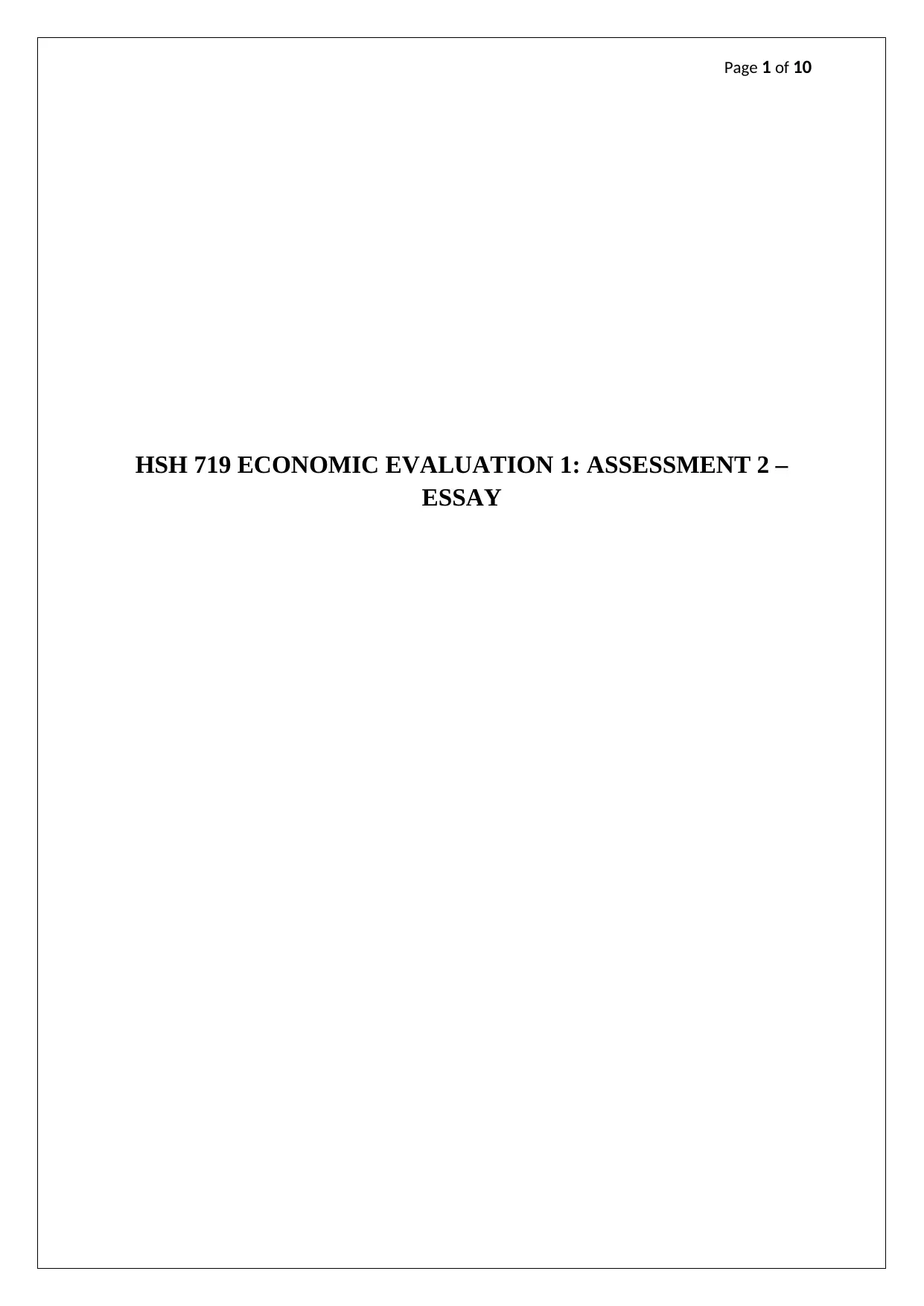
Page 1 of 10
HSH 719 ECONOMIC EVALUATION 1: ASSESSMENT 2 –
ESSAY
HSH 719 ECONOMIC EVALUATION 1: ASSESSMENT 2 –
ESSAY
Paraphrase This Document
Need a fresh take? Get an instant paraphrase of this document with our AI Paraphraser
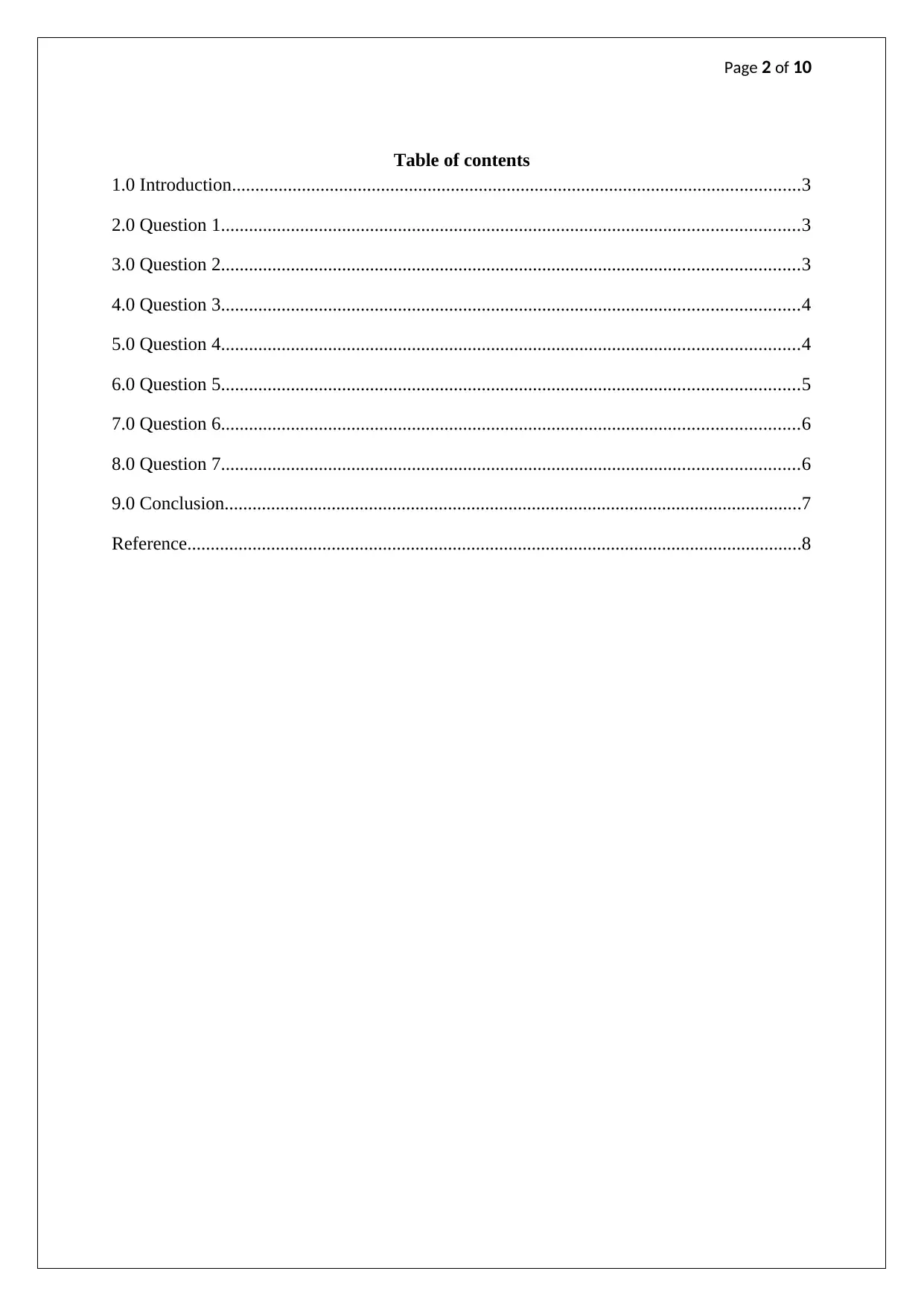
Page 2 of 10
Table of contents
1.0 Introduction..........................................................................................................................3
2.0 Question 1............................................................................................................................3
3.0 Question 2............................................................................................................................3
4.0 Question 3............................................................................................................................4
5.0 Question 4............................................................................................................................4
6.0 Question 5............................................................................................................................5
7.0 Question 6............................................................................................................................6
8.0 Question 7............................................................................................................................6
9.0 Conclusion............................................................................................................................7
Reference....................................................................................................................................8
Table of contents
1.0 Introduction..........................................................................................................................3
2.0 Question 1............................................................................................................................3
3.0 Question 2............................................................................................................................3
4.0 Question 3............................................................................................................................4
5.0 Question 4............................................................................................................................4
6.0 Question 5............................................................................................................................5
7.0 Question 6............................................................................................................................6
8.0 Question 7............................................................................................................................6
9.0 Conclusion............................................................................................................................7
Reference....................................................................................................................................8
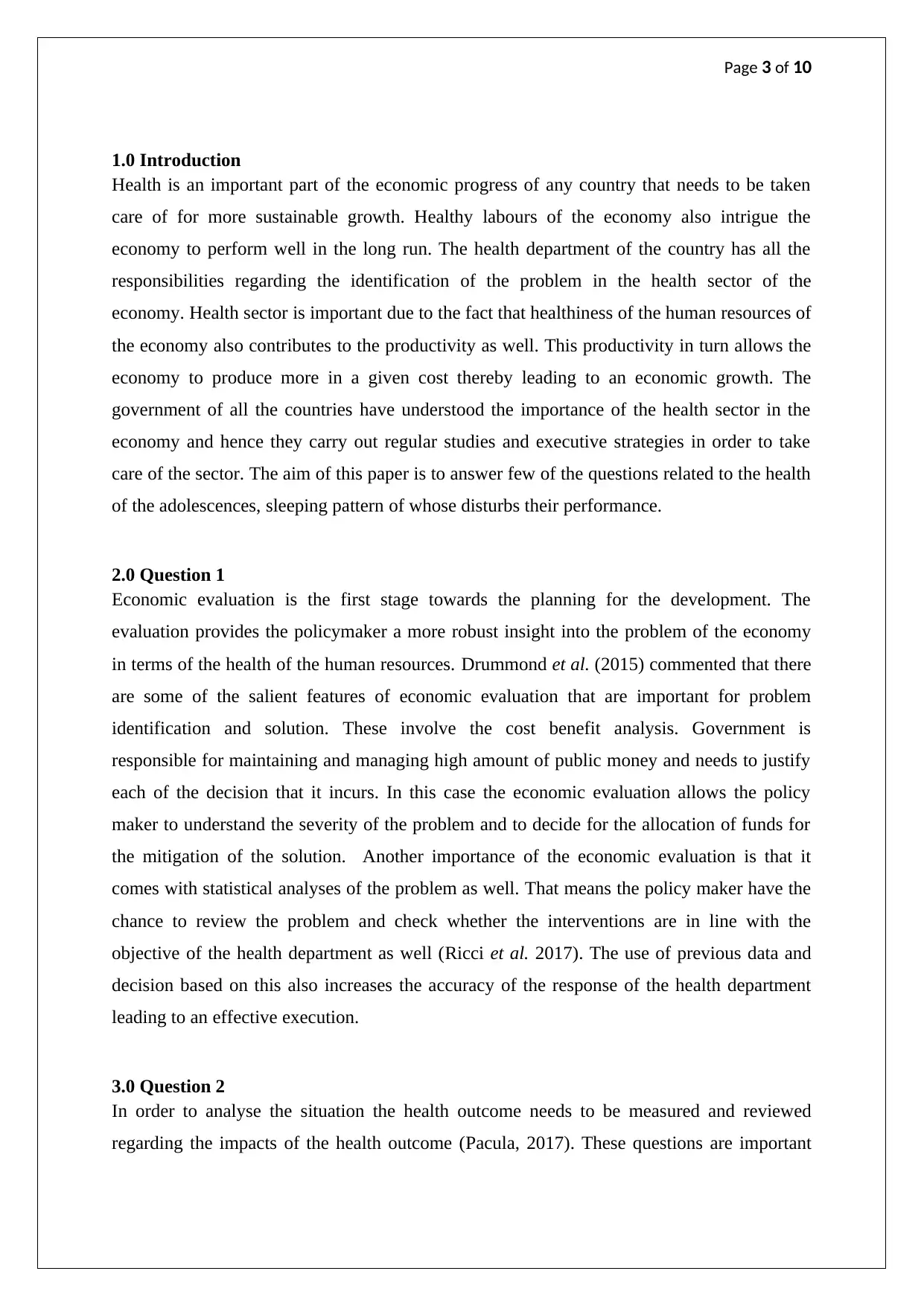
Page 3 of 10
1.0 Introduction
Health is an important part of the economic progress of any country that needs to be taken
care of for more sustainable growth. Healthy labours of the economy also intrigue the
economy to perform well in the long run. The health department of the country has all the
responsibilities regarding the identification of the problem in the health sector of the
economy. Health sector is important due to the fact that healthiness of the human resources of
the economy also contributes to the productivity as well. This productivity in turn allows the
economy to produce more in a given cost thereby leading to an economic growth. The
government of all the countries have understood the importance of the health sector in the
economy and hence they carry out regular studies and executive strategies in order to take
care of the sector. The aim of this paper is to answer few of the questions related to the health
of the adolescences, sleeping pattern of whose disturbs their performance.
2.0 Question 1
Economic evaluation is the first stage towards the planning for the development. The
evaluation provides the policymaker a more robust insight into the problem of the economy
in terms of the health of the human resources. Drummond et al. (2015) commented that there
are some of the salient features of economic evaluation that are important for problem
identification and solution. These involve the cost benefit analysis. Government is
responsible for maintaining and managing high amount of public money and needs to justify
each of the decision that it incurs. In this case the economic evaluation allows the policy
maker to understand the severity of the problem and to decide for the allocation of funds for
the mitigation of the solution. Another importance of the economic evaluation is that it
comes with statistical analyses of the problem as well. That means the policy maker have the
chance to review the problem and check whether the interventions are in line with the
objective of the health department as well (Ricci et al. 2017). The use of previous data and
decision based on this also increases the accuracy of the response of the health department
leading to an effective execution.
3.0 Question 2
In order to analyse the situation the health outcome needs to be measured and reviewed
regarding the impacts of the health outcome (Pacula, 2017). These questions are important
1.0 Introduction
Health is an important part of the economic progress of any country that needs to be taken
care of for more sustainable growth. Healthy labours of the economy also intrigue the
economy to perform well in the long run. The health department of the country has all the
responsibilities regarding the identification of the problem in the health sector of the
economy. Health sector is important due to the fact that healthiness of the human resources of
the economy also contributes to the productivity as well. This productivity in turn allows the
economy to produce more in a given cost thereby leading to an economic growth. The
government of all the countries have understood the importance of the health sector in the
economy and hence they carry out regular studies and executive strategies in order to take
care of the sector. The aim of this paper is to answer few of the questions related to the health
of the adolescences, sleeping pattern of whose disturbs their performance.
2.0 Question 1
Economic evaluation is the first stage towards the planning for the development. The
evaluation provides the policymaker a more robust insight into the problem of the economy
in terms of the health of the human resources. Drummond et al. (2015) commented that there
are some of the salient features of economic evaluation that are important for problem
identification and solution. These involve the cost benefit analysis. Government is
responsible for maintaining and managing high amount of public money and needs to justify
each of the decision that it incurs. In this case the economic evaluation allows the policy
maker to understand the severity of the problem and to decide for the allocation of funds for
the mitigation of the solution. Another importance of the economic evaluation is that it
comes with statistical analyses of the problem as well. That means the policy maker have the
chance to review the problem and check whether the interventions are in line with the
objective of the health department as well (Ricci et al. 2017). The use of previous data and
decision based on this also increases the accuracy of the response of the health department
leading to an effective execution.
3.0 Question 2
In order to analyse the situation the health outcome needs to be measured and reviewed
regarding the impacts of the health outcome (Pacula, 2017). These questions are important
⊘ This is a preview!⊘
Do you want full access?
Subscribe today to unlock all pages.

Trusted by 1+ million students worldwide
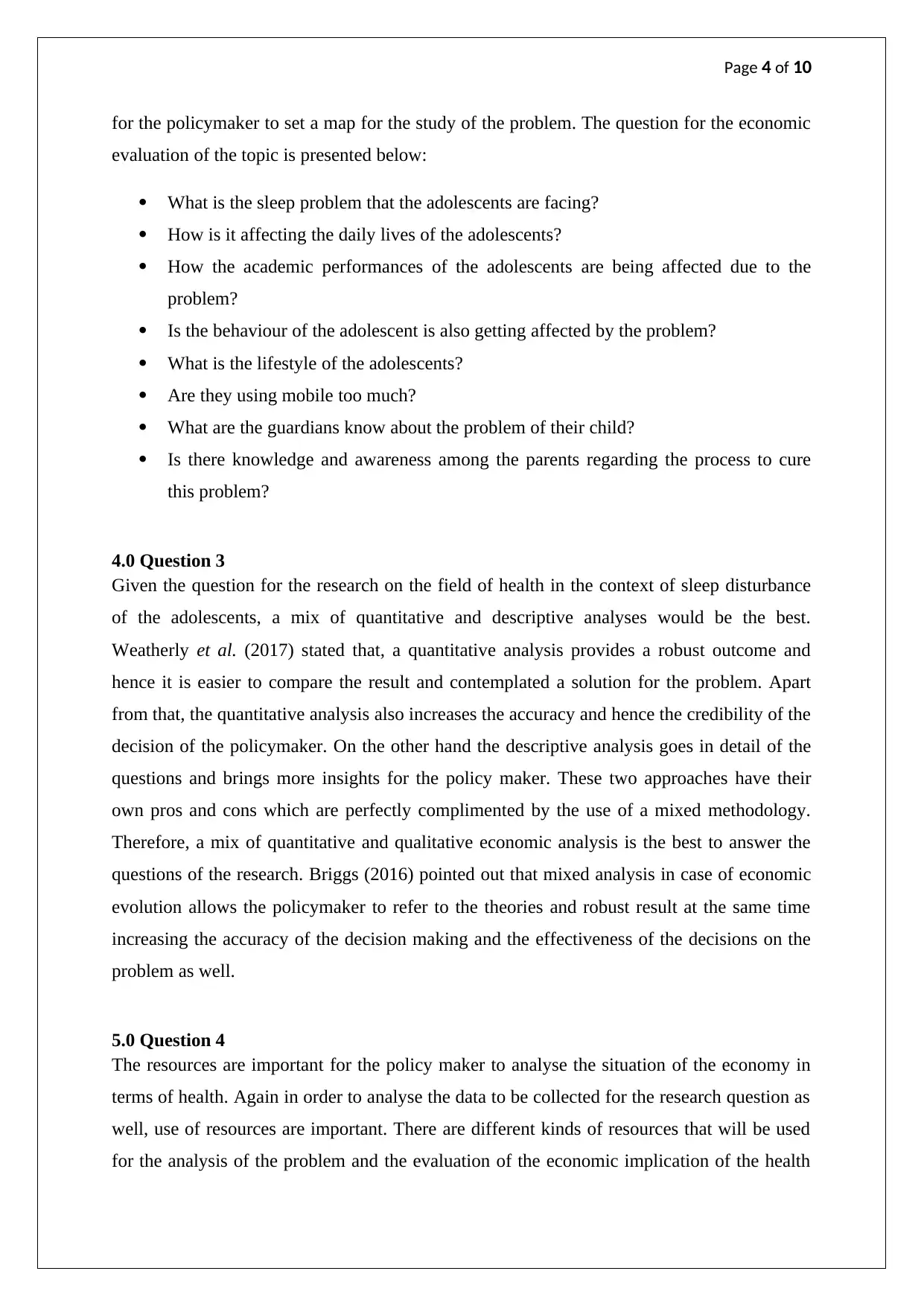
Page 4 of 10
for the policymaker to set a map for the study of the problem. The question for the economic
evaluation of the topic is presented below:
What is the sleep problem that the adolescents are facing?
How is it affecting the daily lives of the adolescents?
How the academic performances of the adolescents are being affected due to the
problem?
Is the behaviour of the adolescent is also getting affected by the problem?
What is the lifestyle of the adolescents?
Are they using mobile too much?
What are the guardians know about the problem of their child?
Is there knowledge and awareness among the parents regarding the process to cure
this problem?
4.0 Question 3
Given the question for the research on the field of health in the context of sleep disturbance
of the adolescents, a mix of quantitative and descriptive analyses would be the best.
Weatherly et al. (2017) stated that, a quantitative analysis provides a robust outcome and
hence it is easier to compare the result and contemplated a solution for the problem. Apart
from that, the quantitative analysis also increases the accuracy and hence the credibility of the
decision of the policymaker. On the other hand the descriptive analysis goes in detail of the
questions and brings more insights for the policy maker. These two approaches have their
own pros and cons which are perfectly complimented by the use of a mixed methodology.
Therefore, a mix of quantitative and qualitative economic analysis is the best to answer the
questions of the research. Briggs (2016) pointed out that mixed analysis in case of economic
evolution allows the policymaker to refer to the theories and robust result at the same time
increasing the accuracy of the decision making and the effectiveness of the decisions on the
problem as well.
5.0 Question 4
The resources are important for the policy maker to analyse the situation of the economy in
terms of health. Again in order to analyse the data to be collected for the research question as
well, use of resources are important. There are different kinds of resources that will be used
for the analysis of the problem and the evaluation of the economic implication of the health
for the policymaker to set a map for the study of the problem. The question for the economic
evaluation of the topic is presented below:
What is the sleep problem that the adolescents are facing?
How is it affecting the daily lives of the adolescents?
How the academic performances of the adolescents are being affected due to the
problem?
Is the behaviour of the adolescent is also getting affected by the problem?
What is the lifestyle of the adolescents?
Are they using mobile too much?
What are the guardians know about the problem of their child?
Is there knowledge and awareness among the parents regarding the process to cure
this problem?
4.0 Question 3
Given the question for the research on the field of health in the context of sleep disturbance
of the adolescents, a mix of quantitative and descriptive analyses would be the best.
Weatherly et al. (2017) stated that, a quantitative analysis provides a robust outcome and
hence it is easier to compare the result and contemplated a solution for the problem. Apart
from that, the quantitative analysis also increases the accuracy and hence the credibility of the
decision of the policymaker. On the other hand the descriptive analysis goes in detail of the
questions and brings more insights for the policy maker. These two approaches have their
own pros and cons which are perfectly complimented by the use of a mixed methodology.
Therefore, a mix of quantitative and qualitative economic analysis is the best to answer the
questions of the research. Briggs (2016) pointed out that mixed analysis in case of economic
evolution allows the policymaker to refer to the theories and robust result at the same time
increasing the accuracy of the decision making and the effectiveness of the decisions on the
problem as well.
5.0 Question 4
The resources are important for the policy maker to analyse the situation of the economy in
terms of health. Again in order to analyse the data to be collected for the research question as
well, use of resources are important. There are different kinds of resources that will be used
for the analysis of the problem and the evaluation of the economic implication of the health
Paraphrase This Document
Need a fresh take? Get an instant paraphrase of this document with our AI Paraphraser
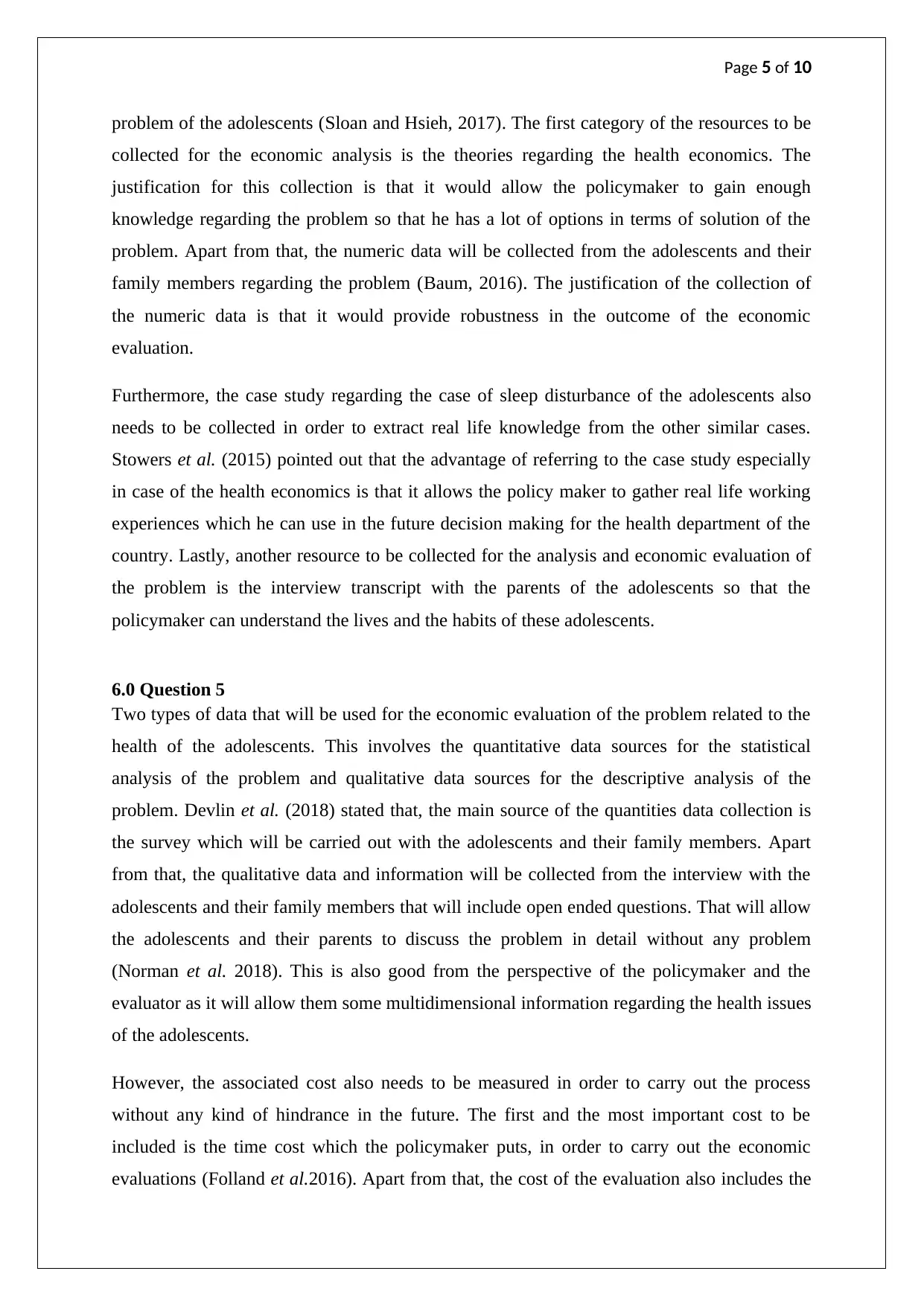
Page 5 of 10
problem of the adolescents (Sloan and Hsieh, 2017). The first category of the resources to be
collected for the economic analysis is the theories regarding the health economics. The
justification for this collection is that it would allow the policymaker to gain enough
knowledge regarding the problem so that he has a lot of options in terms of solution of the
problem. Apart from that, the numeric data will be collected from the adolescents and their
family members regarding the problem (Baum, 2016). The justification of the collection of
the numeric data is that it would provide robustness in the outcome of the economic
evaluation.
Furthermore, the case study regarding the case of sleep disturbance of the adolescents also
needs to be collected in order to extract real life knowledge from the other similar cases.
Stowers et al. (2015) pointed out that the advantage of referring to the case study especially
in case of the health economics is that it allows the policy maker to gather real life working
experiences which he can use in the future decision making for the health department of the
country. Lastly, another resource to be collected for the analysis and economic evaluation of
the problem is the interview transcript with the parents of the adolescents so that the
policymaker can understand the lives and the habits of these adolescents.
6.0 Question 5
Two types of data that will be used for the economic evaluation of the problem related to the
health of the adolescents. This involves the quantitative data sources for the statistical
analysis of the problem and qualitative data sources for the descriptive analysis of the
problem. Devlin et al. (2018) stated that, the main source of the quantities data collection is
the survey which will be carried out with the adolescents and their family members. Apart
from that, the qualitative data and information will be collected from the interview with the
adolescents and their family members that will include open ended questions. That will allow
the adolescents and their parents to discuss the problem in detail without any problem
(Norman et al. 2018). This is also good from the perspective of the policymaker and the
evaluator as it will allow them some multidimensional information regarding the health issues
of the adolescents.
However, the associated cost also needs to be measured in order to carry out the process
without any kind of hindrance in the future. The first and the most important cost to be
included is the time cost which the policymaker puts, in order to carry out the economic
evaluations (Folland et al.2016). Apart from that, the cost of the evaluation also includes the
problem of the adolescents (Sloan and Hsieh, 2017). The first category of the resources to be
collected for the economic analysis is the theories regarding the health economics. The
justification for this collection is that it would allow the policymaker to gain enough
knowledge regarding the problem so that he has a lot of options in terms of solution of the
problem. Apart from that, the numeric data will be collected from the adolescents and their
family members regarding the problem (Baum, 2016). The justification of the collection of
the numeric data is that it would provide robustness in the outcome of the economic
evaluation.
Furthermore, the case study regarding the case of sleep disturbance of the adolescents also
needs to be collected in order to extract real life knowledge from the other similar cases.
Stowers et al. (2015) pointed out that the advantage of referring to the case study especially
in case of the health economics is that it allows the policy maker to gather real life working
experiences which he can use in the future decision making for the health department of the
country. Lastly, another resource to be collected for the analysis and economic evaluation of
the problem is the interview transcript with the parents of the adolescents so that the
policymaker can understand the lives and the habits of these adolescents.
6.0 Question 5
Two types of data that will be used for the economic evaluation of the problem related to the
health of the adolescents. This involves the quantitative data sources for the statistical
analysis of the problem and qualitative data sources for the descriptive analysis of the
problem. Devlin et al. (2018) stated that, the main source of the quantities data collection is
the survey which will be carried out with the adolescents and their family members. Apart
from that, the qualitative data and information will be collected from the interview with the
adolescents and their family members that will include open ended questions. That will allow
the adolescents and their parents to discuss the problem in detail without any problem
(Norman et al. 2018). This is also good from the perspective of the policymaker and the
evaluator as it will allow them some multidimensional information regarding the health issues
of the adolescents.
However, the associated cost also needs to be measured in order to carry out the process
without any kind of hindrance in the future. The first and the most important cost to be
included is the time cost which the policymaker puts, in order to carry out the economic
evaluations (Folland et al.2016). Apart from that, the cost of the evaluation also includes the
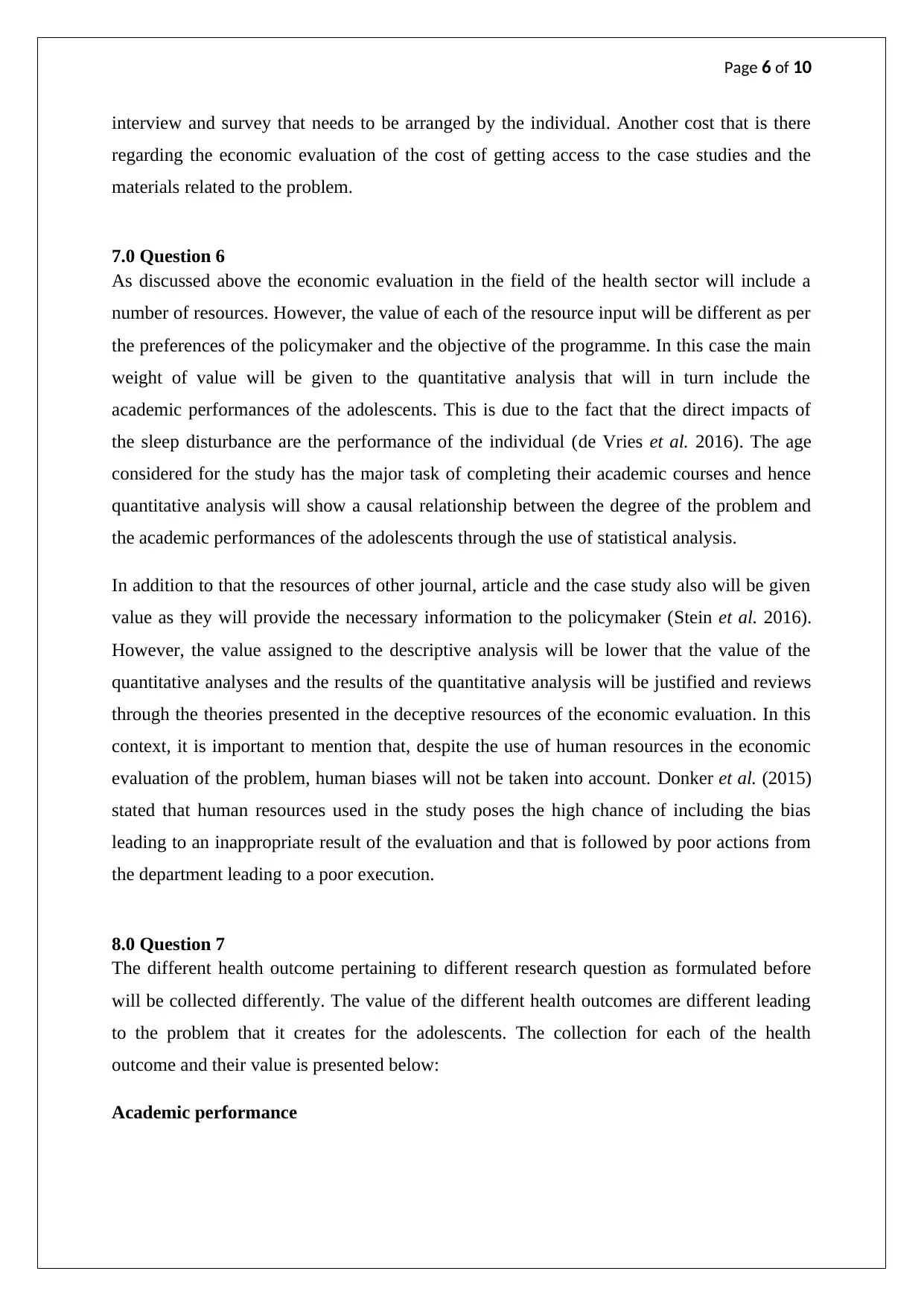
Page 6 of 10
interview and survey that needs to be arranged by the individual. Another cost that is there
regarding the economic evaluation of the cost of getting access to the case studies and the
materials related to the problem.
7.0 Question 6
As discussed above the economic evaluation in the field of the health sector will include a
number of resources. However, the value of each of the resource input will be different as per
the preferences of the policymaker and the objective of the programme. In this case the main
weight of value will be given to the quantitative analysis that will in turn include the
academic performances of the adolescents. This is due to the fact that the direct impacts of
the sleep disturbance are the performance of the individual (de Vries et al. 2016). The age
considered for the study has the major task of completing their academic courses and hence
quantitative analysis will show a causal relationship between the degree of the problem and
the academic performances of the adolescents through the use of statistical analysis.
In addition to that the resources of other journal, article and the case study also will be given
value as they will provide the necessary information to the policymaker (Stein et al. 2016).
However, the value assigned to the descriptive analysis will be lower that the value of the
quantitative analyses and the results of the quantitative analysis will be justified and reviews
through the theories presented in the deceptive resources of the economic evaluation. In this
context, it is important to mention that, despite the use of human resources in the economic
evaluation of the problem, human biases will not be taken into account. Donker et al. (2015)
stated that human resources used in the study poses the high chance of including the bias
leading to an inappropriate result of the evaluation and that is followed by poor actions from
the department leading to a poor execution.
8.0 Question 7
The different health outcome pertaining to different research question as formulated before
will be collected differently. The value of the different health outcomes are different leading
to the problem that it creates for the adolescents. The collection for each of the health
outcome and their value is presented below:
Academic performance
interview and survey that needs to be arranged by the individual. Another cost that is there
regarding the economic evaluation of the cost of getting access to the case studies and the
materials related to the problem.
7.0 Question 6
As discussed above the economic evaluation in the field of the health sector will include a
number of resources. However, the value of each of the resource input will be different as per
the preferences of the policymaker and the objective of the programme. In this case the main
weight of value will be given to the quantitative analysis that will in turn include the
academic performances of the adolescents. This is due to the fact that the direct impacts of
the sleep disturbance are the performance of the individual (de Vries et al. 2016). The age
considered for the study has the major task of completing their academic courses and hence
quantitative analysis will show a causal relationship between the degree of the problem and
the academic performances of the adolescents through the use of statistical analysis.
In addition to that the resources of other journal, article and the case study also will be given
value as they will provide the necessary information to the policymaker (Stein et al. 2016).
However, the value assigned to the descriptive analysis will be lower that the value of the
quantitative analyses and the results of the quantitative analysis will be justified and reviews
through the theories presented in the deceptive resources of the economic evaluation. In this
context, it is important to mention that, despite the use of human resources in the economic
evaluation of the problem, human biases will not be taken into account. Donker et al. (2015)
stated that human resources used in the study poses the high chance of including the bias
leading to an inappropriate result of the evaluation and that is followed by poor actions from
the department leading to a poor execution.
8.0 Question 7
The different health outcome pertaining to different research question as formulated before
will be collected differently. The value of the different health outcomes are different leading
to the problem that it creates for the adolescents. The collection for each of the health
outcome and their value is presented below:
Academic performance
⊘ This is a preview!⊘
Do you want full access?
Subscribe today to unlock all pages.

Trusted by 1+ million students worldwide
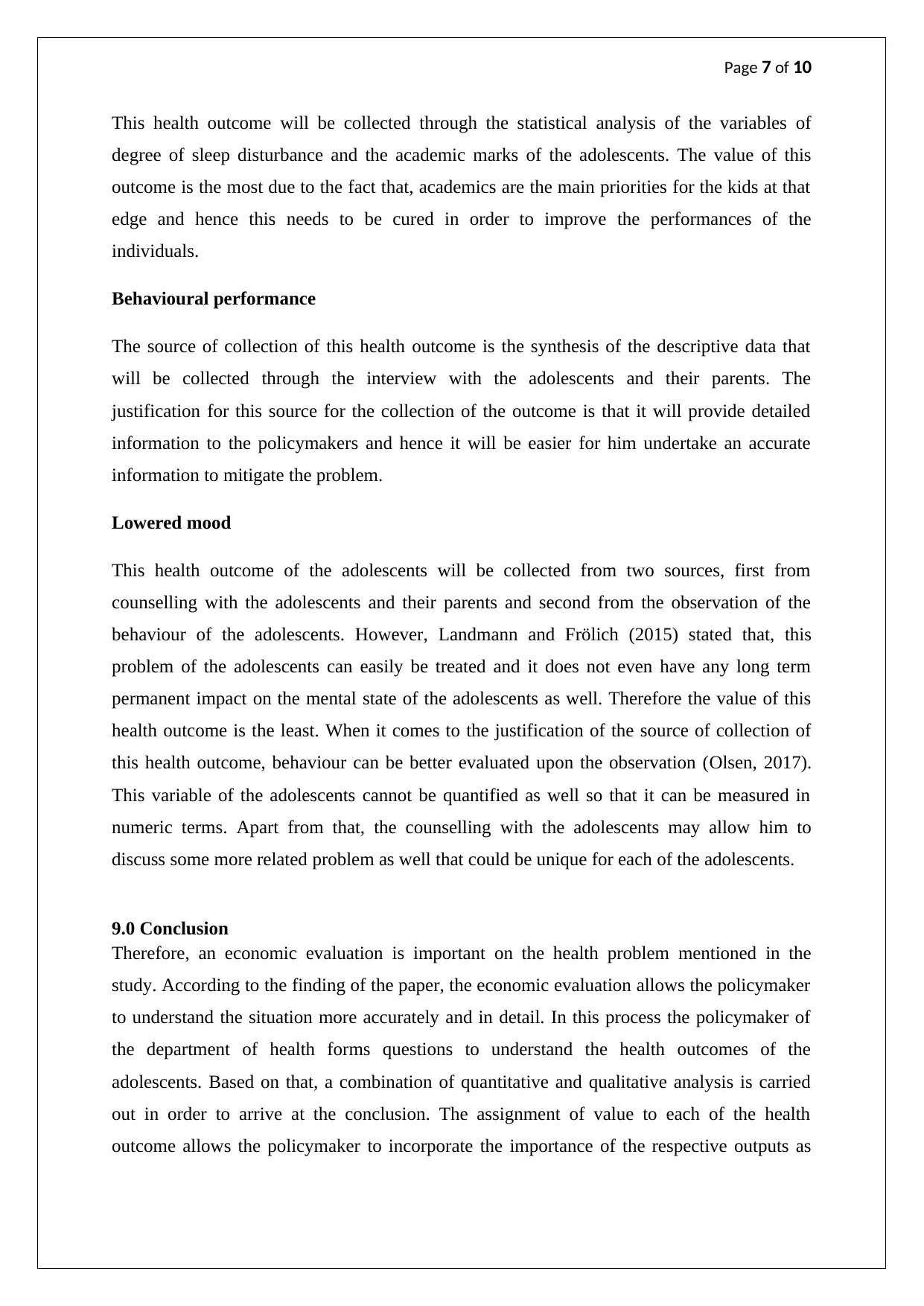
Page 7 of 10
This health outcome will be collected through the statistical analysis of the variables of
degree of sleep disturbance and the academic marks of the adolescents. The value of this
outcome is the most due to the fact that, academics are the main priorities for the kids at that
edge and hence this needs to be cured in order to improve the performances of the
individuals.
Behavioural performance
The source of collection of this health outcome is the synthesis of the descriptive data that
will be collected through the interview with the adolescents and their parents. The
justification for this source for the collection of the outcome is that it will provide detailed
information to the policymakers and hence it will be easier for him undertake an accurate
information to mitigate the problem.
Lowered mood
This health outcome of the adolescents will be collected from two sources, first from
counselling with the adolescents and their parents and second from the observation of the
behaviour of the adolescents. However, Landmann and Frölich (2015) stated that, this
problem of the adolescents can easily be treated and it does not even have any long term
permanent impact on the mental state of the adolescents as well. Therefore the value of this
health outcome is the least. When it comes to the justification of the source of collection of
this health outcome, behaviour can be better evaluated upon the observation (Olsen, 2017).
This variable of the adolescents cannot be quantified as well so that it can be measured in
numeric terms. Apart from that, the counselling with the adolescents may allow him to
discuss some more related problem as well that could be unique for each of the adolescents.
9.0 Conclusion
Therefore, an economic evaluation is important on the health problem mentioned in the
study. According to the finding of the paper, the economic evaluation allows the policymaker
to understand the situation more accurately and in detail. In this process the policymaker of
the department of health forms questions to understand the health outcomes of the
adolescents. Based on that, a combination of quantitative and qualitative analysis is carried
out in order to arrive at the conclusion. The assignment of value to each of the health
outcome allows the policymaker to incorporate the importance of the respective outputs as
This health outcome will be collected through the statistical analysis of the variables of
degree of sleep disturbance and the academic marks of the adolescents. The value of this
outcome is the most due to the fact that, academics are the main priorities for the kids at that
edge and hence this needs to be cured in order to improve the performances of the
individuals.
Behavioural performance
The source of collection of this health outcome is the synthesis of the descriptive data that
will be collected through the interview with the adolescents and their parents. The
justification for this source for the collection of the outcome is that it will provide detailed
information to the policymakers and hence it will be easier for him undertake an accurate
information to mitigate the problem.
Lowered mood
This health outcome of the adolescents will be collected from two sources, first from
counselling with the adolescents and their parents and second from the observation of the
behaviour of the adolescents. However, Landmann and Frölich (2015) stated that, this
problem of the adolescents can easily be treated and it does not even have any long term
permanent impact on the mental state of the adolescents as well. Therefore the value of this
health outcome is the least. When it comes to the justification of the source of collection of
this health outcome, behaviour can be better evaluated upon the observation (Olsen, 2017).
This variable of the adolescents cannot be quantified as well so that it can be measured in
numeric terms. Apart from that, the counselling with the adolescents may allow him to
discuss some more related problem as well that could be unique for each of the adolescents.
9.0 Conclusion
Therefore, an economic evaluation is important on the health problem mentioned in the
study. According to the finding of the paper, the economic evaluation allows the policymaker
to understand the situation more accurately and in detail. In this process the policymaker of
the department of health forms questions to understand the health outcomes of the
adolescents. Based on that, a combination of quantitative and qualitative analysis is carried
out in order to arrive at the conclusion. The assignment of value to each of the health
outcome allows the policymaker to incorporate the importance of the respective outputs as
Paraphrase This Document
Need a fresh take? Get an instant paraphrase of this document with our AI Paraphraser
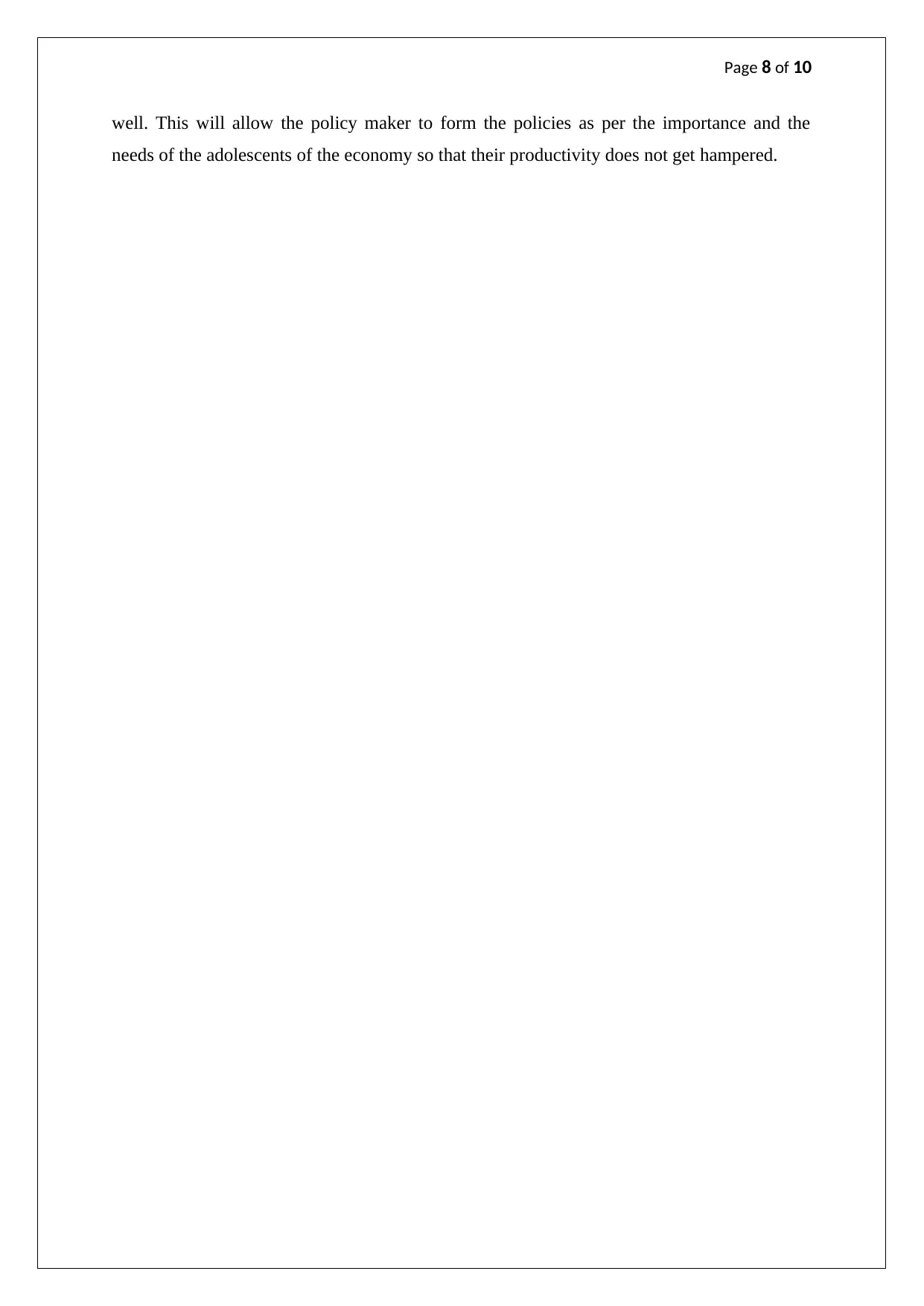
Page 8 of 10
well. This will allow the policy maker to form the policies as per the importance and the
needs of the adolescents of the economy so that their productivity does not get hampered.
well. This will allow the policy maker to form the policies as per the importance and the
needs of the adolescents of the economy so that their productivity does not get hampered.
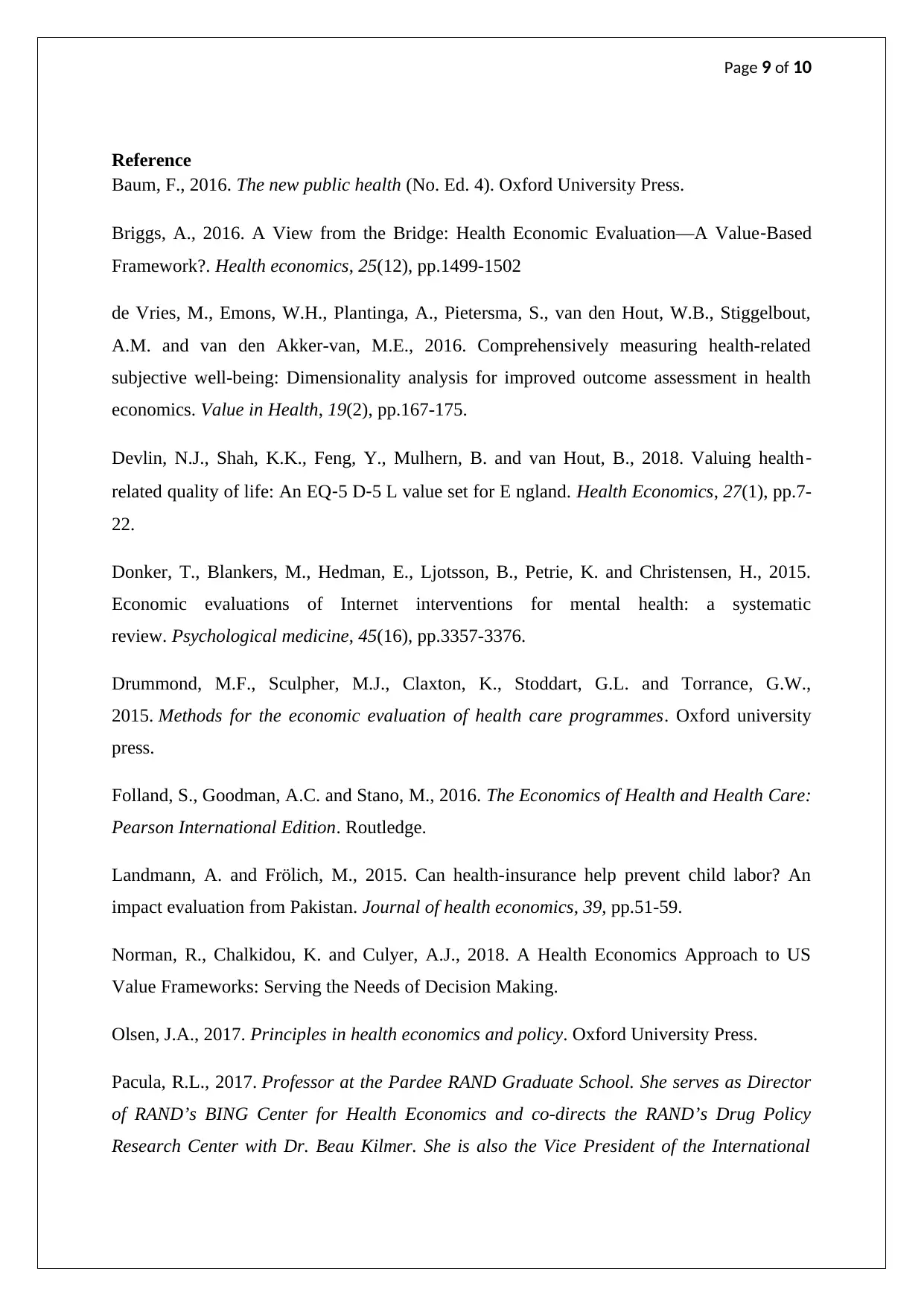
Page 9 of 10
Reference
Baum, F., 2016. The new public health (No. Ed. 4). Oxford University Press.
Briggs, A., 2016. A View from the Bridge: Health Economic Evaluation—A Value‐Based
Framework?. Health economics, 25(12), pp.1499-1502
de Vries, M., Emons, W.H., Plantinga, A., Pietersma, S., van den Hout, W.B., Stiggelbout,
A.M. and van den Akker-van, M.E., 2016. Comprehensively measuring health-related
subjective well-being: Dimensionality analysis for improved outcome assessment in health
economics. Value in Health, 19(2), pp.167-175.
Devlin, N.J., Shah, K.K., Feng, Y., Mulhern, B. and van Hout, B., 2018. Valuing health‐
related quality of life: An EQ‐5 D‐5 L value set for E ngland. Health Economics, 27(1), pp.7-
22.
Donker, T., Blankers, M., Hedman, E., Ljotsson, B., Petrie, K. and Christensen, H., 2015.
Economic evaluations of Internet interventions for mental health: a systematic
review. Psychological medicine, 45(16), pp.3357-3376.
Drummond, M.F., Sculpher, M.J., Claxton, K., Stoddart, G.L. and Torrance, G.W.,
2015. Methods for the economic evaluation of health care programmes. Oxford university
press.
Folland, S., Goodman, A.C. and Stano, M., 2016. The Economics of Health and Health Care:
Pearson International Edition. Routledge.
Landmann, A. and Frölich, M., 2015. Can health-insurance help prevent child labor? An
impact evaluation from Pakistan. Journal of health economics, 39, pp.51-59.
Norman, R., Chalkidou, K. and Culyer, A.J., 2018. A Health Economics Approach to US
Value Frameworks: Serving the Needs of Decision Making.
Olsen, J.A., 2017. Principles in health economics and policy. Oxford University Press.
Pacula, R.L., 2017. Professor at the Pardee RAND Graduate School. She serves as Director
of RAND’s BING Center for Health Economics and co-directs the RAND’s Drug Policy
Research Center with Dr. Beau Kilmer. She is also the Vice President of the International
Reference
Baum, F., 2016. The new public health (No. Ed. 4). Oxford University Press.
Briggs, A., 2016. A View from the Bridge: Health Economic Evaluation—A Value‐Based
Framework?. Health economics, 25(12), pp.1499-1502
de Vries, M., Emons, W.H., Plantinga, A., Pietersma, S., van den Hout, W.B., Stiggelbout,
A.M. and van den Akker-van, M.E., 2016. Comprehensively measuring health-related
subjective well-being: Dimensionality analysis for improved outcome assessment in health
economics. Value in Health, 19(2), pp.167-175.
Devlin, N.J., Shah, K.K., Feng, Y., Mulhern, B. and van Hout, B., 2018. Valuing health‐
related quality of life: An EQ‐5 D‐5 L value set for E ngland. Health Economics, 27(1), pp.7-
22.
Donker, T., Blankers, M., Hedman, E., Ljotsson, B., Petrie, K. and Christensen, H., 2015.
Economic evaluations of Internet interventions for mental health: a systematic
review. Psychological medicine, 45(16), pp.3357-3376.
Drummond, M.F., Sculpher, M.J., Claxton, K., Stoddart, G.L. and Torrance, G.W.,
2015. Methods for the economic evaluation of health care programmes. Oxford university
press.
Folland, S., Goodman, A.C. and Stano, M., 2016. The Economics of Health and Health Care:
Pearson International Edition. Routledge.
Landmann, A. and Frölich, M., 2015. Can health-insurance help prevent child labor? An
impact evaluation from Pakistan. Journal of health economics, 39, pp.51-59.
Norman, R., Chalkidou, K. and Culyer, A.J., 2018. A Health Economics Approach to US
Value Frameworks: Serving the Needs of Decision Making.
Olsen, J.A., 2017. Principles in health economics and policy. Oxford University Press.
Pacula, R.L., 2017. Professor at the Pardee RAND Graduate School. She serves as Director
of RAND’s BING Center for Health Economics and co-directs the RAND’s Drug Policy
Research Center with Dr. Beau Kilmer. She is also the Vice President of the International
⊘ This is a preview!⊘
Do you want full access?
Subscribe today to unlock all pages.

Trusted by 1+ million students worldwide
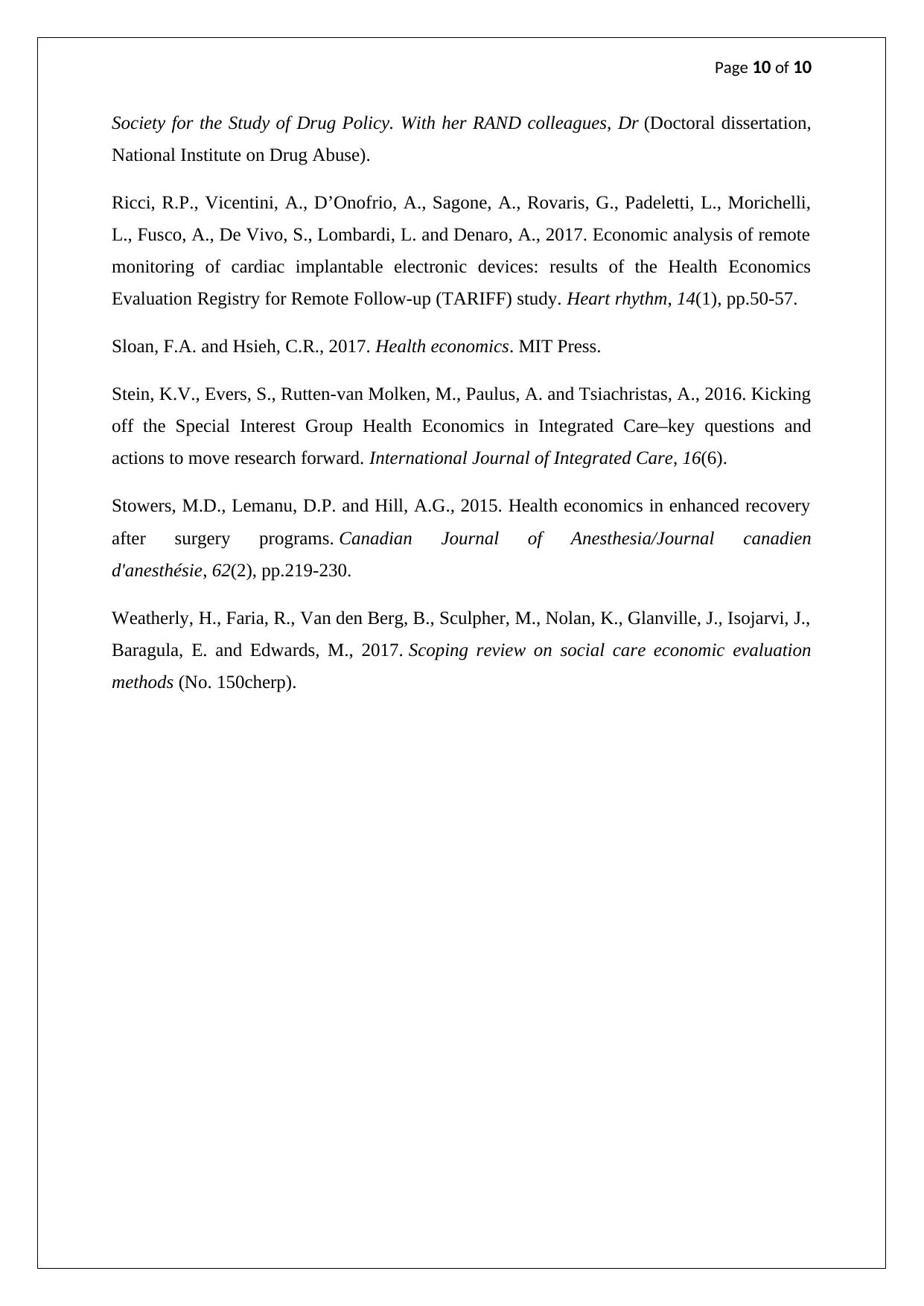
Page 10 of 10
Society for the Study of Drug Policy. With her RAND colleagues, Dr (Doctoral dissertation,
National Institute on Drug Abuse).
Ricci, R.P., Vicentini, A., D’Onofrio, A., Sagone, A., Rovaris, G., Padeletti, L., Morichelli,
L., Fusco, A., De Vivo, S., Lombardi, L. and Denaro, A., 2017. Economic analysis of remote
monitoring of cardiac implantable electronic devices: results of the Health Economics
Evaluation Registry for Remote Follow-up (TARIFF) study. Heart rhythm, 14(1), pp.50-57.
Sloan, F.A. and Hsieh, C.R., 2017. Health economics. MIT Press.
Stein, K.V., Evers, S., Rutten-van Molken, M., Paulus, A. and Tsiachristas, A., 2016. Kicking
off the Special Interest Group Health Economics in Integrated Care–key questions and
actions to move research forward. International Journal of Integrated Care, 16(6).
Stowers, M.D., Lemanu, D.P. and Hill, A.G., 2015. Health economics in enhanced recovery
after surgery programs. Canadian Journal of Anesthesia/Journal canadien
d'anesthésie, 62(2), pp.219-230.
Weatherly, H., Faria, R., Van den Berg, B., Sculpher, M., Nolan, K., Glanville, J., Isojarvi, J.,
Baragula, E. and Edwards, M., 2017. Scoping review on social care economic evaluation
methods (No. 150cherp).
Society for the Study of Drug Policy. With her RAND colleagues, Dr (Doctoral dissertation,
National Institute on Drug Abuse).
Ricci, R.P., Vicentini, A., D’Onofrio, A., Sagone, A., Rovaris, G., Padeletti, L., Morichelli,
L., Fusco, A., De Vivo, S., Lombardi, L. and Denaro, A., 2017. Economic analysis of remote
monitoring of cardiac implantable electronic devices: results of the Health Economics
Evaluation Registry for Remote Follow-up (TARIFF) study. Heart rhythm, 14(1), pp.50-57.
Sloan, F.A. and Hsieh, C.R., 2017. Health economics. MIT Press.
Stein, K.V., Evers, S., Rutten-van Molken, M., Paulus, A. and Tsiachristas, A., 2016. Kicking
off the Special Interest Group Health Economics in Integrated Care–key questions and
actions to move research forward. International Journal of Integrated Care, 16(6).
Stowers, M.D., Lemanu, D.P. and Hill, A.G., 2015. Health economics in enhanced recovery
after surgery programs. Canadian Journal of Anesthesia/Journal canadien
d'anesthésie, 62(2), pp.219-230.
Weatherly, H., Faria, R., Van den Berg, B., Sculpher, M., Nolan, K., Glanville, J., Isojarvi, J.,
Baragula, E. and Edwards, M., 2017. Scoping review on social care economic evaluation
methods (No. 150cherp).
1 out of 10
Related Documents
Your All-in-One AI-Powered Toolkit for Academic Success.
+13062052269
info@desklib.com
Available 24*7 on WhatsApp / Email
![[object Object]](/_next/static/media/star-bottom.7253800d.svg)
Unlock your academic potential
Copyright © 2020–2025 A2Z Services. All Rights Reserved. Developed and managed by ZUCOL.





